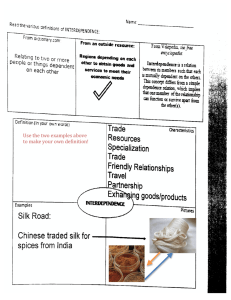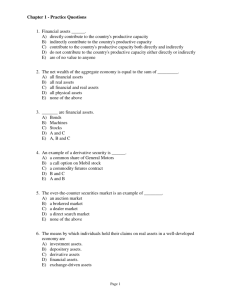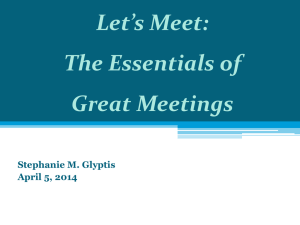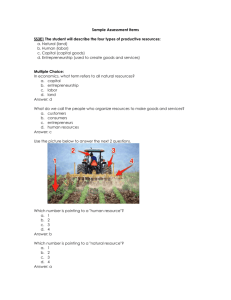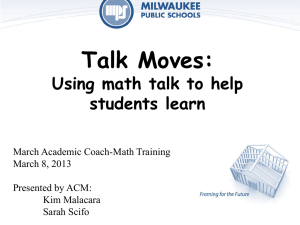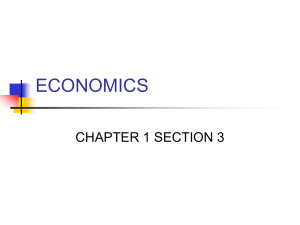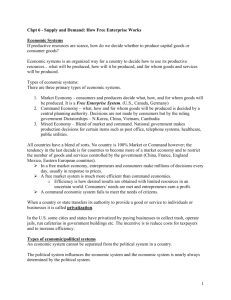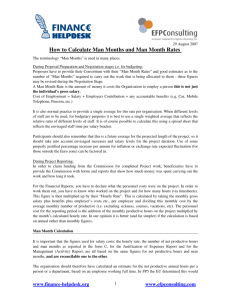Resources and Production - Delaware Department of Education
advertisement
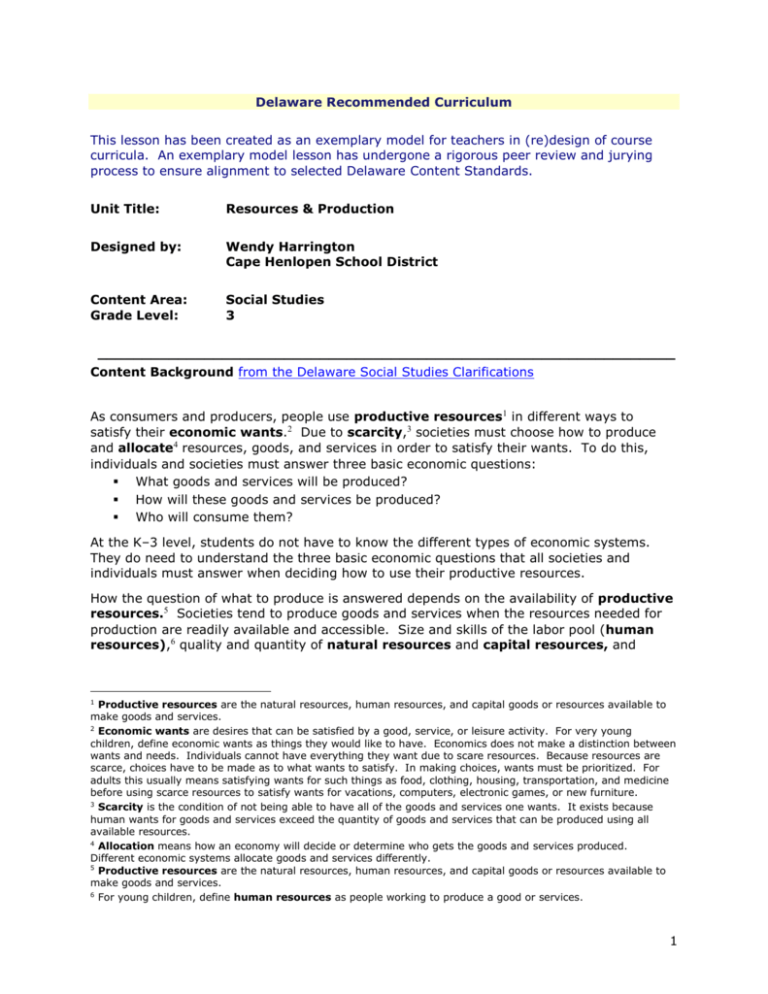
Delaware Recommended Curriculum This lesson has been created as an exemplary model for teachers in (re)design of course curricula. An exemplary model lesson has undergone a rigorous peer review and jurying process to ensure alignment to selected Delaware Content Standards. Unit Title: Resources & Production Designed by: Wendy Harrington Cape Henlopen School District Content Area: Grade Level: Social Studies 3 _________________________________________________________________ Content Background from the Delaware Social Studies Clarifications As consumers and producers, people use productive resources1 in different ways to satisfy their economic wants.2 Due to scarcity,3 societies must choose how to produce and allocate4 resources, goods, and services in order to satisfy their wants. To do this, individuals and societies must answer three basic economic questions: What goods and services will be produced? How will these goods and services be produced? Who will consume them? At the K–3 level, students do not have to know the different types of economic systems. They do need to understand the three basic economic questions that all societies and individuals must answer when deciding how to use their productive resources. How the question of what to produce is answered depends on the availability of productive resources.5 Societies tend to produce goods and services when the resources needed for production are readily available and accessible. Size and skills of the labor pool (human resources),6 quality and quantity of natural resources and capital resources, and Productive resources are the natural resources, human resources, and capital goods or resources available to make goods and services. 2 Economic wants are desires that can be satisfied by a good, service, or leisure activity. For very young children, define economic wants as things they would like to have. Economics does not make a distinction between wants and needs. Individuals cannot have everything they want due to scare resources. Because resources are scarce, choices have to be made as to what wants to satisfy. In making choices, wants must be prioritized. For adults this usually means satisfying wants for such things as food, clothing, housing, transportation, and medicine before using scarce resources to satisfy wants for vacations, computers, electronic games, or new furniture. 3 Scarcity is the condition of not being able to have all of the goods and services one wants. It exists because human wants for goods and services exceed the quantity of goods and services that can be produced using all available resources. 4 Allocation means how an economy will decide or determine who gets the goods and services produced. Different economic systems allocate goods and services differently. 5 Productive resources are the natural resources, human resources, and capital goods or resources available to make goods and services. 6 For young children, define human resources as people working to produce a good or services. 1 1 access to technology7 determine how goods and services are produced. Some nations with vast amounts of natural resources have less skilled labor and use little capital. Areas with poor capital resources, limited technology, and large populations tend to rely heavily on human resources in the production process using limited or poor quality tools and equipment. Countries with skilled labor, access to natural resources, and high-quality capital resources use less labor and more machines. However, the mix of resources may change dramatically over time. In K–3, students should learn about different ways goods are produced and the advantages and disadvantages of different methods.8 This usually includes producing something first using the craftsman method and then the specialization and division of labor method. Craftsmen produce goods but do not share the work. Each person produces his or her own good from the first step to the last. Craftsmen may share tools and equipment but not labor. Specialization is when people concentrate their production on fewer kinds of goods and services than they consume. For example, instead of producing several goods, a group or business will concentrate on producing just one good. Division of labor or specialization of labor means human resources (workers) perform only a single, or very few, step(s) in the production of a product, as they do when working on an assembly line. Specialization and division of labor usually increase the productivity of workers which means an increase in the number of goods produced per worker. Productivity is a measurement of output per worker. Productivity can be increased through specialization and division of labor, by investment in human capital (education and training), and investment in capital goods (tools and equipment). _________________________________________________________________ For young children, talk about natural resources as things that grow outside, things that come from the ground, or things that live outside using examples such as animals, fruits and vegetables, sun, air, flowers, mountains, and water. For young children, define capital resources as goods produced and used to make other goods and services. Technology is the operation and processes of how work is done. Students often have misconceptions about technology, thinking it refers to more recent advances such as robotics and computers. In fact, technology includes many ways of doing work. This includes a craftsman making goods by hand, the assembly line, and division of labor where the production of a good is broken down into numerous separate tasks, and new tools and equipment such as computers. 8 Advantages and disadvantages of different production methods – Advantages of the craftsman method of production include the satisfaction of producing a product from beginning to end and variety during the workday. Disadvantages include learning and perfecting all the skills needed for production, slower production, and the need to stop and retool. Advantages of division of labor include speed and expertise from learning only one step of the process and not needing to retool or wait to use resources. Disadvantages include boredom from doing the same job all day and what to do when workers are absent and other workers do not have the same skills. An advantage of specialization is individuals become very good at what they do. A disadvantage is specialists must rely on others to produce the goods and services they do not produce. 7 2 Stage 1 – Desired Results What students will know, do, and understand _________________________________________________________________ Delaware Content Standards Economics Standard Three K-3a: Students will identify human wants and the various resources and strategies that have been used to satisfy them over time. CCSS.ELA-Literacy.W.3.8 Recall information from experiences or gather information from print and digital sources; take brief notes on sources and sort evidence into provided categories. CCSS.ELA-Literacy.W.3.2 Write informative/explanatory texts to examine a topic and convey ideas and information clearly. CCSS.ELA-Literacy.SL.3.1.d Explain their own ideas and understanding in light of the discussion. Big Ideas Resources Interdependence Essential Questions How should people use what they have to get what they want? Why have different ways to produce and allocate goods and services developed? Knowledge Students will know… Production Resources Natural Human Capital Division of Labor Assembly Line Production 3 Stage 2 – Assessment Evidence Evidence that will be collected to determine whether or not Desired Results are achieved _________________________________________________________________ Transfer Task This summative assessment is a transfer task that should be reviewed with students prior to using the activities in the unit. Essential Question Measured by the Transfer Task How should people use what they have to get what they want? Prior Knowledge You have just learned that people use resources in different ways to satisfy their wants. Problem A bad storm has caused your school to lose power. No lunch has been made. The only choice for lunch today is a jelly sandwich, an apple, and a carton of milk. Classes will eat in their classroom because the cafeteria is dark. So, each child’s lunch must be placed in a box. The principal has asked your class to make the lunches for the entire school. She needs the 500 lunches in one hour. The boxes need to be put together: The apples need to be washed and dried. The sandwiches need to be made and wrapped in paper. A carton of milk must be put in each box. The lunches must be packed and counted on carts for each classroom. Role/Perspective You are a student in the class. Product/Performance Complete the chart for the resources you will need. Next, write a plan that tells what your class needs to do so that everyone’s lunch is ready in one hour. Be sure to explain why you chose that plan. Criteria for Exemplary Response The chart shows the correct category for the productive resources. The plan tells what your class needs to do so that everyone’s lunch is ready in one hour. The plan demonstrates how you would use productive resources. The explanation includes an understanding of why specialization increases production and cuts down on time. 4 Chart Resources and Production Natural Human Capital 5 Transfer Task Rubric Scoring Category Score Point 3 Score Point 2 Score Point 1 The chart categorizes the productive resources needed The chart accurately categorized all productive resources The chart accurately categorized most productive resources The chart accurately categorized few productive resources The plan explains what each member of the class needs to do so that everyone’s lunch is ready in one hour The plan is well developed and clearly explained The plan is partially developed with a somewhat clear explanation The plan is minimally developed and an unclear explanation The plan demonstrates how you would use productive resources The plan clearly demonstrates how you would use the productive resources The plan somewhat demonstrates how you would use the productive resources The plan minimally demonstrates how you would use the productive resources The plan explains the reason(s) why specialization increases production and cuts down on time The explanation is thoroughly developed The explanation is partially developed The explanation is minimally developed Uses contentappropriate vocabulary in order to demonstrate understanding Content appropriate vocabulary is well developed & evident Some evidence of content appropriate vocabulary usage Minimal evidence of content appropriate vocabulary usage Total Score: ________ Above the Standard: 13 to 15 points Meets the Standard: 8 to 12 points Below the Standard: 5 to 7 points 6 Stage 3 – Learning Plan Design learning activities to align with Stage 1 and Stage 2 expectations _________________________________________________________________ Lesson: Resources and Production Instructional Strategies Strategy 1: Gathering Information Think\Pair\Share Ask the students: Think about how lemonade is made. Individually, list the materials necessary to make lemonade. Students should then pair with another to compare lists. Finally, have students share their lists with the class. Compile the list for the class on a board or wall. We are using lemonade as an example of a product that people make with resources. Tell the students: You will learn about producers and the three kinds of productive resources that are used to make things. In this example, the producer is the person who makes the lemonade, the person who brings together all of the things on our list—the productive resources. So the things on the list used to make lemonade are called productive resources. We call a person who makes a good or provides a service a producer, like the person who might make lemonade. Can you name some producers and tell what good or service they produce? Pick one of the producers that students named and ask: How does that producer make their good or provide their service? What productive resources are used? When students initially learn new concepts or terms, it is important to not just give a definition. An informal explanation or example provides a viable starting place for learning. In later strategies, students will refine their understanding and correct any misconceptions. Check for Understanding Write down what producer and productive resources means. Tell your partner. How is your explanation different from your partner’s explanation? Rubric 2 – This response gives a valid difference with accurate and relevant reasoning. 1 – This response gives a valid difference with an inaccurate, irrelevant, or no reasoning. 7 Strategy 2: Extending & Refining Categorizing Divide the students into groups of 2–3. For each group, write the following terms (include any other valid suggestions from students) on index cards. lemons cutting board lemon juice large glass jar or pitcher sugar long-handled spoon knife water measuring cup cup or drinking glass Tell students that anything that is used to make goods and services that people want are called productive resources. There are three kinds of productive resources: natural, human, and capital resources. Write the terms on the Word Wall. Natural resources are things from nature that can be used to make goods or services. Human resources are workers that are needed to make goods and services. Capital resources are things made by people that are used to make other goods or services. For each group of 2-3, have students group the productive resources used to make lemonade into the three categories above. Conduct a class discussion once students are finished to help clear up any misconceptions about the three categories. Note to Teacher: If it is not mentioned, ask students if there is anything missing from the list of productive resources used to make lemonade. Someone has to stir the lemonade with the spoon—it could be mechanical but is probably a human resource. Strategy 3: Extending & Refining Sequencing Events Ask students in small groups of 2-3 to think about how a plant grows. Have the students use a storyboard like the one below. Students should draw the steps in how a plant grows in each box, and then write whether the step in producing a plant requires natural, human, or capital resources. For instance, if a group says that sunshine is needed, sunshine is a natural resource. Click here for a reproducible copy of the storyboard. 8 Note to Teachers: Be aware of misconceptions in sequencing: it is not necessarily important that all steps in plant growth (from seedling to maturity) are recalled, but rather that the steps each group does show on the poster board are in the correct sequence and the productive resources are correctly identified. Strategy 4: Extending & Refining Graphic Organizers Have students read the book The Little Red Hen.9 An online version of The Little Red Hen can be found here. Keep in mind there will be several elements to identify in the story: Production – the steps in producing a loaf of bread. Resources – natural, human, and capital resources needed in the production process. Have students work together, in small groups of 2 or 3, to identify the productive resources that are used to make bread in the story and write each productive resource on an index card. Provide each group with a large piece of chart paper divided into three sections: natural, human, and capital. Have the groups cooperatively sort the cards to fit the three categories. Have them fill in the chart and display it on the wall. Discuss the completed charts and assess them for accuracy. You may also use The Ox-Cart Man by Donald Hall and illustrated by Barbara Cooney. There are numerous products and productive resources found in this Caldecott Medal winning tale. Published by Puffin Books, copyright 1979, 1983. ISBN 0-14-050441-9. 9 9 Resources Needed to Produce a Loaf of Bread Natural Human Capital Ask students to re-read the story of the Little Red Hen to look for the tasks needed to produce the loaf of bread. Record each task on a separate index card and arrange the cards in the proper sequence. Have the groups share their sequence of tasks and initiate a discussion to have the total class come to consensus on the correct sequence. Have each group contribute to a bulletin board display using pictures to illustrate the sequence of events used to produce bread by the Little Red Hen. Use the bulletin board to initiate a discussion of the production process. Ask the following questions: How could the production process be improved so that the Little Red Hen could make more than one loaf of bread? Would more bread be produced in the same amount of time if work was shared by other animals in the story? Why? Check for Understanding Write a letter to the Little Red Hen to tell her how resources could be changed so that she could produce more bread. Rubric 2 - This response gives a valid example with an accurate and relevant explanation. 1 - This response gives a valid example with an inaccurate, irrelevant, or no explanation. 10 Strategy 5: Application Problem-Solving Divide students into groups of four or five. Have their chairs and desks arranged to form a common work surface. Give each student a new box of 8, 12, or 24 crayons per student (use boxes of all the same crayon count). Determine by asking individual students in each group how many crayons of each color are in each box. For example, how many red crayons are in each box? How many are blue? Record the correct number of individual colors for each box as a reference. Ask each student within each group to open their own box and spill the contents in a large pile in the middle, mixing up the crayons as they add more. Have your students carefully unfold the crayon box so that it is flattened. It is now your job to put back together one box of crayons per student. We will keep track of how long it takes each group. You will have to put the correct crayon colors back into your box. Refer the students to the correct number of colored crayons in each box. Raise your hand when you are finished, and I will record how much time it took on the board (keep track for each group). Do not keep track of which student finished and how much time—it is more important to see how long it takes to put all the boxes back together. When all the boxes have been reassembled, add up the total time for each of the groups— e.g., group A took X minutes, group B took Y minutes, etc. Note: This is a good time to integrate mathematics. Students should examine how long it took each group to finish the crayon sorting. Can you think of a way to make the job easier? You will want to encourage the idea of an assembly line or division of labor—e.g., they might first sort the crayons according to color, then each student could place several crayons in the box and then hand the box to the next child until the box is back together, and filled properly. Or, all the students could work to sort the crayons and each could participate in the reloading of each box. Have the students do the sorting activity again, this time using the easier process. Record the time for this round. Have your students refer to the tip sheet if they need some help thinking of ways they could improve their assembly line. 11 Check for Understanding Your class wants to earn money for a field trip. You have decided to sell decorated sugar cookies. You have 30 minutes of class time to decorate as many cookies as you can. What is the best way to produce the most cookies? Why? Rubric 2 – This response gives a valid decision with an accurate and relevant explanation. 1 – This response gives a valid decision with an inaccurate, irrelevant, or no explanation. Check for Understanding This picture shows a farm worker hauling apples with a tractor near Winchester, VA. 10 What productive resources are used to produce apples? Be sure to explain why each resource is a natural, capital, or human resource. Rubric 2 – This response gives a valid example with an accurate and relevant explanation. 1 – This response gives a valid example with an inaccurate, irrelevant, or no explanation. How would producing apples be different without capital resources? Explain your answer. Rubric 2 – This response gives a valid difference with an accurate and relevant explanation. 1 – This response gives a valid difference with an inaccurate, irrelevant, or no explanation. 10 USDA Online Photography Center, #95cs0648: CD0056-014 12
